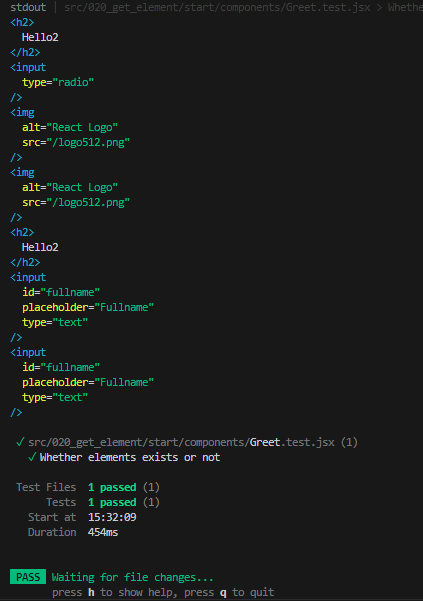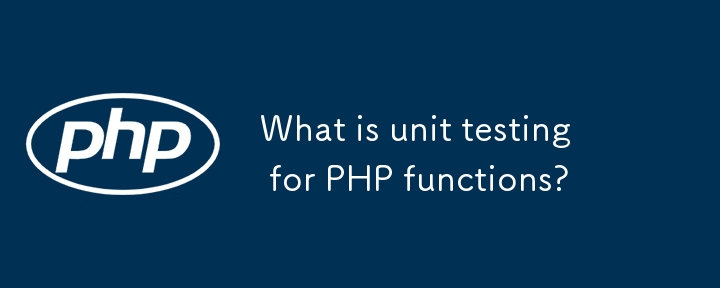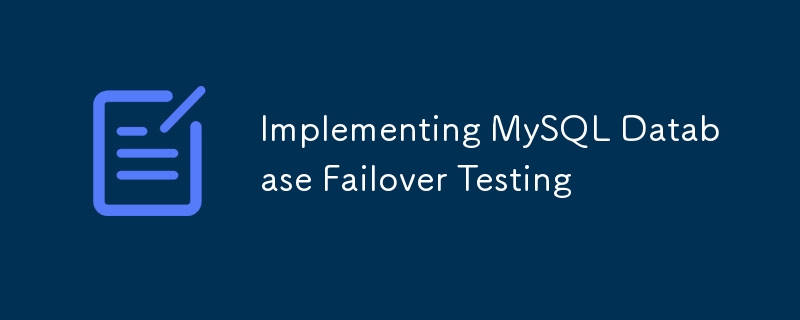Found a total of 10000 related content

How to test a Yii application
Article Introduction:To test Yii2 applications, you must first configure the test environment and write the test using Codeception or PHPUnit. 1. Install codeception/codeception and other development dependencies through Composer; 2. Run vendor/bin/codeceptbootstrap to initialize the test directory; 3. Configure tests/codeception/config/config.php and set up an independent test database; 4. Use vendor/bin/codeceptgenerate:testunit to create unit tests, verify models and other components; 5. Pass assertFal in unit tests
2025-08-22
comment 0
224

Mock your Test Dependencies with Mockery
Article Introduction:While not everyone is doing this, testing your application is one of the most basic parts of being a developer. Unit testing is the most common test. With unit testing, you can check if a class is running exactly as you expected. Sometimes, you are using third-party services in your application, and it's hard to set up everything for unit testing. This is when the simulation comes into play.
Key Points
Mocking is the process of creating a substitute for real objects in a unit test, which is especially useful when testing applications that rely heavily on dependency injection.
Mockery is a library created by Pádraic Brady that can be used to mock objects in unit tests and is the default mock of PHPUnit
2025-02-20
comment 0
392

Methods for PHP unit testing using PhpStorm
Article Introduction:PhpStorm was chosen for PHP unit testing because it provides a powerful IDE and built-in support for PHPUnit, making test writing and running more convenient and efficient. 1. Install and configure PHPUnit to ensure version compatibility. 2. Use smart code prompts to write test cases. 3. Run the test in the IDE and view the results. 4. Use the code coverage tool to ensure comprehensive testing. 5. Position and fix testing problems through debugging functions.
2025-05-20
comment 0
1047

How to write unit tests for WordPress code
Article Introduction:Writing WordPress unit tests requires using PHPUnit and WordPress test suites. 1. Set up the environment: Install PHP and Composer, install PHPUnit through Composer, clone the wordpress-develop repository, configure a dedicated database, and use wpscaffold to generate test files. 2. Understand the test structure: inherit the WP_UnitTestCase class, the test method starts with test_, and use the factory class to create test data to avoid real HTTP requests. 3. Write effective tests: cover normal and boundary situations, verify function behavior, hook triggers, and shortcode output, keep the test independent and focused. 4. Run and debug:
2025-07-25
comment 0
244

React Basics~unit test/ui
Article Introduction:When I test current code, which is unit test, I use some tools. They are jest and react-testing-library.
?src/Example.js
import Greet from "./components/Greet";
const Example = () => {
return ;
};
export default Example;
?s
2024-10-20
comment 0
330

From PHPUnit to Go: Data-Driven Unit Testing for Go Developers
Article Introduction:In this post, we'll explore how to bring the PHP unit testing mindset, particularly the PHPUnit framework's data provider approach, into Go. If you're an experienced PHP developer, you’re likely familiar with the data provider model: gathering test d
2024-11-12
comment 0
462

API Client TDD with Mocked Responses
Article Introduction:This tutorial expands on a previous installment, focusing on building a robust and well-tested Diffbot API client library using PHPUnit and TDD (Test-Driven Development). The previous parts covered basic functionality and abstract class testing. Thi
2025-02-18
comment 0
1029

What is unit testing for PHP functions?
Article Introduction:Unit testing in PHP refers to writing small, independent tests for separate functions to verify that their behavior is as expected. For example, when testing an addition function using the PHPUnit framework, you can write the following test case: publicfunctiontestAddReturnsSumOfTwoNumbers(){$this->assertEquals(5,add(2,3));}, which verifies whether the output of add(2,3) is 5. The importance of unit testing includes: 1. Early detection of errors; 2. Support for secure reconstruction; 3. Documented function behavior. The steps to start using PHP unit test are: 1. Install through Composer
2025-07-21
comment 0
579

How to Write JavaScript-Style Test Watchers in PHP
Article Introduction:Core points
Integrate JavaScript-style test observers into PHP projects, automate preprocessing of file conversions, and rerun unit tests when files change, thus improving development efficiency.
Set up automated tests with tools such as PHPUnit and observe file modifications using PHPUnit-Watcher to ensure immediate feedback and error detection during development.
Implementing preprocessing scripts in a PHP project allows syntax conversions similar to JavaScript Babel, improving compatibility and reducing manual encoding efforts.
Configure the PHP test environment to automatically rebuild preprocessed files before testing, thus maintaining accurate generation
2025-02-09
comment 0
905

Troubleshooting MySQL Replication Delays and Lag
Article Introduction:Common causes and troubleshooting methods for MySQL master-slave replication delay are as follows: 1. Check the network status, use ping/traceroute to test delays and packet loss, use telnet to test port connectivity, and test the actual bandwidth through iperf; 2. Analyze the slave library processing capabilities, check the Seconds_Behind_Master field, monitor the CPU, memory, and IO usage, and enable multi-threaded replication to improve parallel capabilities; 3. Confirm the write pressure of the master library, use SHOWPROCESSLIST to check long-term write operations, optimize slow queries, and reduce replication link load; 4. Check the rationality of replication configuration, adjust sync_relay_log, relay_log_recov
2025-07-28
comment 0
937

Testing Your Tests? Who Watches the Watchmen?
Article Introduction:Whether you are working for a large enterprise, a startup, or yourself, unit testing is not only useful, but is often indispensable. We use unit tests to test the code, but what if our tests are wrong or incomplete? What can we use to test our tests? Who will supervise the inspector?
Key Points
Variation testing is a technique that evaluates its quality with a small number of modified tests and can be used to test the test itself. It involves creating a "variant" or variant of the original test and checking if these changes are detected by the test.
Humbug is a variant testing framework for PHP that can be used to generate code coverage. However, it is PHPUnit-specific and may have problems for users using different testing frameworks
2025-02-14
comment 0
497

How to test a Laravel application
Article Introduction:Configure the test environment, use .env.testing files and independent databases, such as SQLite in-memory databases, and run migrations or use RefreshDatabase; 2. Write functional tests to verify HTTP requests and application processes, and write unit tests to isolate test classes or methods; 3. Use test assistive methods provided by Laravel such as get, post, assertStatus, actingAs, and model factories to generate test data; 4. Run tests using phpunit or phpartisantest to filter specific tests and ensure fast execution; 5. Always use RefreshDatabase, simulate external services, and perform JSON
2025-08-12
comment 0
894

How to write a unit test in Laravel?
Article Introduction:The key to writing Laravel unit tests is to understand its mechanism and structure. 1. Create test classes and can be generated using the Artisan command; 2. Write test methods starting with test_ and use assertion verification logic; 3. Introduce RefreshDatabasetrait when it comes to databases to automatically manage data state; 4. Run tests can be run through the phpunit or phpartisantest command and support the execution of specified classes or methods.
2025-07-22
comment 0
538

Implementing MySQL Database Failover Testing
Article Introduction:The core of database failover testing is to ensure that the system can automatically switch the backup library and continue to run when the main library fails. 1. Before testing, you need to use SHOWSLAVESTATUS\G to check the master-slave replication status to avoid data inconsistencies; 2. Simulation failures should be closer to real scenarios, such as cutting off ports, power outages, etc.; 3. After switching, you need to verify whether the application can connect to the new master library. It is recommended to enable automatic reconnection, use VIP and test the read and write functions; 4. After failure recovery, you need to repair the old master library, pay attention to clearing the conflict configuration and rebuilding the replication link.
2025-07-24
comment 0
140

How to write a unit test for a Vue component that uses Vuex?
Article Introduction:Create a test-specific Vuexstore and initialize it with createStore; 2. Inject store through mount's global.plugins; 3. Use jest.fn() to simulate actions to verify calls; 4. Test the responsiveness of the component when the store state changes; 5. Optionally mock the store partially or use @testing-library/vue; finally implement isolated and reliable unit testing to ensure that the component interacts correctly with Vuex, the test is complete and maintainable.
2025-08-03
comment 0
425

Unit Testing JavaScript with Jest and React Testing Library
Article Introduction:Jest and ReactTestingLibrary are the gold standard for React application testing. Jest provides test runs, assertions, _mock_ and coverage reports. ReactTestingLibrary tests components by simulating user behavior and accessibility queries. If you use CreateReactApp, both are built in. Custom configurations require installing jest, @testing-library/react and setting jest.config.js and Babel configurations; unit tests use test() and expect() to verify function logic, such as formatPrice function formatting results; component test pass r
2025-07-25
comment 0
785

How do I achieve high test coverage in my Laravel application?
Article Introduction:To achieve high test coverage for Laravel applications, the key is to write meaningful tests to verify core logic, boundary situations, and integration points. 1. Use functional tests to simulate real user interactions and cover request/response cycles, controllers, middleware, routing and database operations; 2. Write unit tests for complex business logic, service classes or tools, and use appropriate mocks to isolate the tested classes; 3. Use model factories and seeders to generate consistent test data, and keep the test efficient through RefreshDatabase; 4. Use PHPUnit or Pest for coverage, focusing on important paths rather than simply pursuing row count coverage. Balance different test types, focus on actual functions and dependency logic, and gradually improve test coverage.
2025-06-17
comment 0
274

JavaScript Testing Tool Showdown: Sinon.js vs testdouble.js
Article Introduction:When unit testing real-world code, many situations make the test difficult to write. How to check if a function is called? How to test Ajax calls? Or code using setTimeout? At this time, you need to use Test Stand-in-Replace the code to make it easier to test within difficult to test.
Sinon.js has been the actual standard for creating test stand-ins in JavaScript testing for years. It is an essential tool for any JavaScript developer who writes tests, because without it, it is nearly impossible to write tests for real applications.
Recently, a new library called testdouble.js is on the rise. It has a
2025-02-16
comment 0
1148

Tutorial for App Engine service code unit testing using Go
Article Introduction:This article describes how to write unit tests for code using App Engine services in Go. Through the appenginetesting library, developers can simulate the App Engine environment, so as to test the interactive logic with Datastore, Memcache and other services without relying on actual App Engine deployment, and improve testing efficiency and code quality.
2025-08-18
comment 0
686

Unit testing with mocked dependencies in Laravel
Article Introduction:In Laravel unit tests, the logic to be tested can be isolated and side effects can be avoided by mocking dependencies. 1. Simulation dependency can improve test speed and stability; 2. External service behavior can be preset to verify code response; 3. Create mock objects using PHPUnit and Laravel auxiliary methods; 4. Select mock, stub or fake according to needs; 5. Keep the interface concise and use simulation reasonably to avoid excessive simulation.
2025-07-03
comment 0
623



















